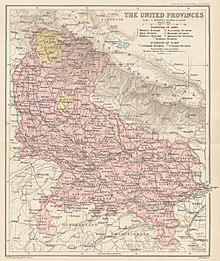Wikipedia:Reference desk/Archives/Humanities/2018 July 27
| Humanities desk | ||
|---|---|---|
| < July 26 | << Jun | July | Aug >> | July 28 > |
| Welcome to the Wikipedia Humanities Reference Desk Archives |
|---|
| The page you are currently viewing is an archive page. While you can leave answers for any questions shown below, please ask new questions on one of the current reference desk pages. |
July 27[edit]
Lalitpur[edit]
Why is the Lalitpur district part of Uttar Pradesh, rather than being part of the state that almost completely surrounds it, Madhya Pradesh? The article talks about territory transfers after the Sepoy Rebellion, so its attachment to UP seemingly doesn't reflect conquests by some local raja before the establishment of the Empire of India. Nyttend (talk) 12:29, 27 July 2018 (UTC)


- Short answer: Historical contingency (redlink!).
- Long answer: Uttar Pradesh was formed in 1948 from the territories of the British-ruled province of United Provinces of Agra and Oudh, which contained Jhansi District (which then consisted of region covered by present day Jhansi and Lalitpur districts). So why were the present day Lalitpur region and Jhansi region part of United Provinces in the first place? The British had acquired them from the rulers of Jhansi state and the Scindias of the Gwalior State in the 1842-1886 period, and incorporated them into the United Provinces.
- Also note that at the time the Indian states were originally formed in ca. 1950 it wouldn't have been so, say, geometrically obvious that the (then) Jhansi district should be part of Madhya Pradesh as it existed then, or the states of Madhya Bharat or Vindhya Pradesh, all of which were amalgamation of princely states (while, as noted above, Jhansi-Lalitpur was derived from a British ruled province). As for why the Lalitpur district wasn't transferred to Madhya Pradesh in one of the subsequent state reorganizations? Your guess is as good as mine but, surprisingly, I haven't even found any indication that people are agitating to do so. So, I assume, the residents and the two state governments are happy enough with the current arrangement. Abecedare (talk) 22:24, 29 July 2018 (UTC)
- Part of the answer would seem to be inertia. When the Indian army invaded Goa the intention was to incorporate it into the neighbouring state of Maharashtra. Problems of assimilimation meant that it remained a union territory for 25 years and then became India's 25th state. The remainder of the Estado da Índia remains union territory, and Goa still uses a version of the Portuguese Civil Code. 86.131.233.223 (talk) 10:33, 30 July 2018 (UTC)
City of Lütah, China[edit]
I am reading a UN report from the 1960's and it talks about the city of Lütah in China. What is the modern name of this city? Population in '60 of about 1.5M.
(edit: fixed typo and added pop) 74.83.121.73 (talk) 20:59, 27 July 2018 (UTC)
- According to this it is Lutan. Other editors may be able to find more info for you. MarnetteD|Talk 21:18, 27 July 2018 (UTC)
- IP editor, you've changed the question now, so the answer will be different. Dbfirs 22:49, 27 July 2018 (UTC)
